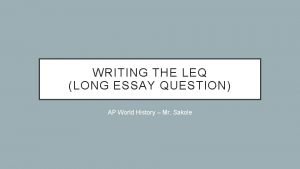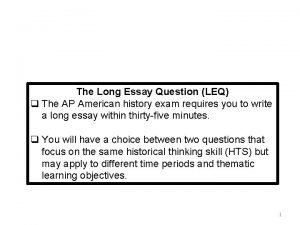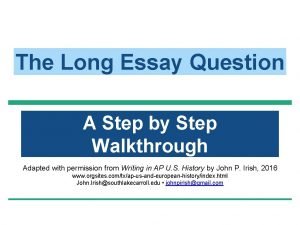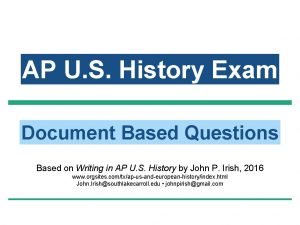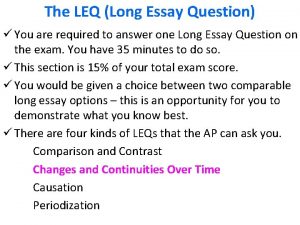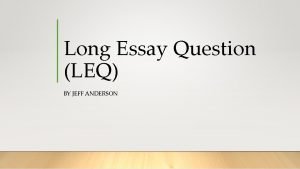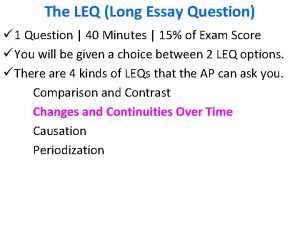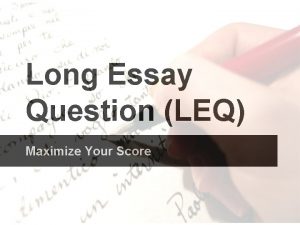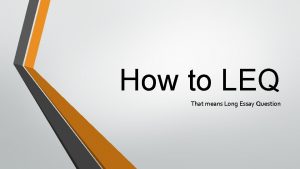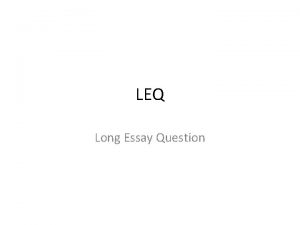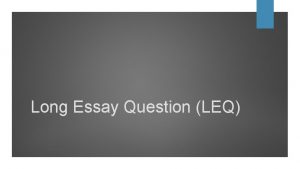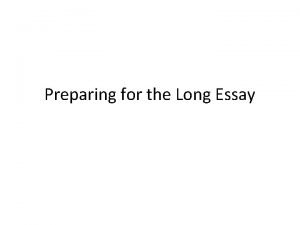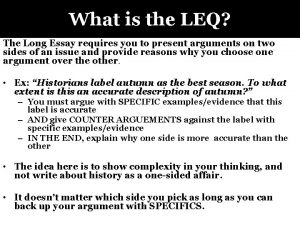The LEQ Long Essay Question You are required















- Slides: 15

The LEQ (Long Essay Question) ü You are required to answer one Long Essay Question on the exam. You have 35 minutes to do so. ü This section is 15% of your total exam score. ü You would be given a choice between two comparable long essay options – this is an opportunity for you to demonstrate what you know best. ü There are four kinds of LEQs that the AP can ask you. Comparison and Contrast Changes and Continuities Over Time Causation Periodization

About the CCOT LEQ: You must ü analyze and evaluate historical patterns of continuity and change over time. ü Connect patterns of continuity and change over time to larger historical processes or themes.

Your CCOT Question: Using specific evidence, analyze economic continuities and changes in commerce along the Silk Roads in the period from 600 to 1450 CE.

SPICE Social • Gender roles and relations • Family and kinship • Racial and ethnic constructions • Social and economic classes Political • Political structures and forms of government • Empires • Nations and nationalism • Revolts and revolutions • Regional, trans-regional, and global structures and organizations Interactions • Demography and disease • Migration • Patterns of Settlement • Technology Culture • Religions • Belief systems, philosophies, and ideologies • Science and technology • The arts and architecture Economic • Agricultural and pastoral production • Trade and commerce • Labor systems • Industrialization • Capitalism and Socialism

Silk Road Chronology 600 CE 700 CE Roman Empire Byzantine Empire. Tang dynasty: Silk Road reaches its golden age. Islam founded & expands Muslims control Mesopotamia and Iran, along with the Silk and Spice routes. 800 CE Porcelain, compass, & gunpowder made in China. Venice established as a city-state. Arabs conquer Spain Block printing developed in China Tang dynasty declines, and with it, the Silkroad. 900 CE Tang Dynasty ends China fragmented. Song Dynasty reunites China.

1000 CE 1100 CE First Crusade Exchange of technology between Europe and SW Asia. Genghis Khan unites Mongols. Paper money developed in China. 1200 CE 1300 CE Death of Genghis Khan. Mongols invade central and Western Asia, Russia & E Europe Pax Mongolia Kublai Khan establishes Yuan dynasty. Marco Polo leaves for the East. Ottoman Empire in power. Tamerlane Empire Ibn Battuta, travels to China. Black Death spreads Asia to Europe. Cannons used first in Europe. Mongol Yuan Dynasty collapses. Chinese Ming Dynasty begins. 1400 - 1450 CE Renaissance begins in Western Europe. Zheng He Decline of Mongols. Ottomans conquer Constantinople. Gutenberg printing press in use. Ming China closes the door to foreigners. Reduces Silk Road trade.

LEQ RUBRIC Points Skill: Contextualization Situates the argument by explaining 1 the broader historical events, developments, or processes immediately relevant to the question Must be more than a phrase; requires an explanation typically consisting of multiple sentences or a full paragraph. Information here cannot be repeated in the body paragraphs. Skill: Argumentation (E 1) : THESIS States a thesis that makes a historically defensible claim and responds to all parts of the question 1 Describes historical continuity AND changes over time. 1 Explains the reasons for historical continuity AND change over time 1 1

LEQ RUBRIC Continued… Points Skill: Argumentation: SOPHISTICATION OF SUPPORTING EVIDENCE AND ARGUMENTATION Addresses the topic of the question with specific examples of relevant evidence (1) Utilizes specific examples of evidence to fully and effectively substantiate thesis or relevant argument. Must include a broad range of evidence that, through analysis and explanation, justifies thesis or a relevant argument (1) 2 SYNETHESIS: Extends the argument by explaining the connections between the argument and: A development in a different historical period, situation, era, or geographical area OR A course theme and/or approach to history that is not the focus of the essay (political, social, etc. ) OR A different discipline or field of inquiry (such as econ, gov & politics, art history, or anthropology 1

Bad or “Meh” Theses: Figure out WHY In the years of 600 CE-1450 CE, there were many changes in patterns of Silk Road trade such as religion and empires, but there were also continuities in Silk Road trade such as technology. During the period of 600 CE to 1450 CE, patterns of interaction both changed and remained the same due to the rise and fall of different societies. Over the centuries from 600 CE to 1450 CE, the Silk Road grew from a local network to a massively extensive system of commerce spanning thousands of miles and incorporating many nations and commodities.

SAMPLE THESIS Between 600 CE and 1450 CE there was continual trade along the Silk Roads. However, different empires in power had differing values towards trade and merchants, which affected the overall economies of these empires, and the usage of the Silk Roads. The Byzantines were conquered by the Ottoman Empire in eastern Europe, and the Song dynasty changed to the Yuan and Ming Empires in Eastern Asia. The origin of the Silk Road began within the Han Dynasty in Chang’an and continued throughout the Roman Empire. The Silk Road linked the regions of the ancient world in commerce.

Body Paragraphs Using Previous Thesis Topic Sentence 1: Between 600 and 1000 CE, the Byzantines dominated trade along the western end of the Silk Roads at Constantinople, while the Tang and later Song dynasties dominated trade at the eastern end. Supporting Detail: Changes: Continuities: Topic Sentence 2: By 1450 the Ottomans had wrestled control of the western Silk Roads from the Byzantines, while the Yuan and later Ming Dynasties took over the eastern end. Supporting Detail: Changes: Continuities:

Historical Context ü Need to place changes in the larger world context and identify what GLOBAL events brought about changes. ü Also discuss how continuities persist despite these global forces that bring about change ü You must make an extra-regional connection or a global process to explain continuity or change in your essay. For example, saying that “The Byzantines and China both had trade” is a comparison, not a connection.

I Introduction: Outlining Your Essay A) Thesis statement must: ü Include time period: 600 – 1450 CE ü Include region: Silk Roads (include end points such as East Asia and Western Europe) ü Include at least 2 changes and 1 continuity, or 1 change and 2 continuities B) Historical context II Body Paragraph One Changes III Body Paragraph Two Continuities IV Conclusion A) Prove your thesis statement B) Historical context (if you haven’t already discussed it) C) Synthesis: Make a connection to another region and/or to today

Synthesis Suggestions for this essay: ü Discuss the Silk Roads ccot briefly for Period 2 (Classical Era) ü Discuss why China is trying to bring back the Silk Road today “China has announced a $46 bn investment plan which will largely centre on an economic corridor from Gwadar in Pakistan to Kashgar in the Chinese region of Xinjiang. ” http: //www. bbc. com/news/world-asia-32400091 “Combined with an overland route through Eurasia, the project is known as “One Belt, One Road. ” https: //www. bloomberg. c om/news/articles/2016 -08 -14/why-china-s-plan-tobuild-a-new-silk-road-runs -through-singapore

Terms to use Changes Continuities Previously Lasting Up until Enduring Formerly Ongoing From that point forward Sustained Prior to Maintained
 Insidan region jh
Insidan region jh Costas level
Costas level Short short short long long long short short short
Short short short long long long short short short In the old days there lived
In the old days there lived Từ ngữ thể hiện lòng nhân hậu
Từ ngữ thể hiện lòng nhân hậu How to write a leq
How to write a leq Long essay question
Long essay question What is a topic outline
What is a topic outline Long essay question apush
Long essay question apush Leq essay
Leq essay Leq format
Leq format Question without question words
Question without question words Closed question
Closed question Contoh open question
Contoh open question Example of factor relating questions
Example of factor relating questions How much does it cost indirect question
How much does it cost indirect question





